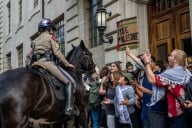You have /5 articles left.
Sign up for a free account or log in.
Still a few weeks shy of my sixth birthday, I went to Yellowstone National Park for the first time. Late in the day, we drove through the park’s iconic Hayden Valley, my father eventually pulling off the road near Alum Creek. A lone bull bison stood to the east along the creek’s meandering course, at the base of water-carved bluffs.
“Let’s walk out and see him,” my dad whispered to me. “We can stand right above on top of that small cliff.”
By now the light was fading into chromatic oranges, our path rendered sharply in a warm glow that belied the falling temperatures. Our breath showed with each exhale, and eventually the passage became too much for my 5-year-old legs. I begged a ride. Fingers encased in my father’s dark and wavy hair, ankles gripped securely, my eyes still scanning the landscape for the grizzly bear that I was certain would pop up any second. The top of the Alum bluffs drew near. A final small rise, another 100 feet, and we’d be there.
Both of us were looking at the cliff’s demarcation as we crested the last slope, so we did not see him until he stood. No more than 30 feet before us, he rose as though lifted from earth below, his head alone taller than me, his shoulders and imposing hump swathed in a woolen dark brown that gave way in jagged edges to smooth haunches of a lighter shade. Like ours, his breath floated in the air before him while the single eye we could see gleamed red in the last direct rays of the sun. My father froze, and I could feel the tension in his hands and shoulders.
I sank a couple inches with my father’s slow and pronounced exhale. I realized he had not been breathing. But then the bull lowered his head to tear free a mouthful of grass, took an oblique step away from us, grazed again. My dad began to slowly back away. As he did, my take on the scene zoomed wide, the bull and his hanging puffs of air framed by dark-green hills and the first traces of snow on the higher peaks to the northwest, all of it aflush. I felt lit from within.
It was perhaps the first of many such moments that led me to a career in environmental science -- a career full of good fortune and opportunity, and of deep satisfaction in the research I got to conduct and the related messages I could carry forward to ever broadening circles as my career grew. But this spring, I set much of that aside. I left one of the world’s leading universities for environmental research -- a terrific position directing an institute central to that mission and reputation, and an opportunity to maintain a significant research presence -- to become the provost of Colorado College. Why?
I had many reasons, including some deeply personal ones. But above all, I’ve come to believe that our primary barriers to solving environmental challenges do not lie in the technical details of how the world around us works or the solutions we require. To be sure, both of those remain vitally important, especially the latter. And yet, I fear none of those solutions will take hold at the scale and pace that we require unless we focus above all on our increasingly decaying community bonds. Last year, when asked to write a think piece on my field for one of its core journals, I concluded with this: “The path our country and world follows will not rest upon the next article any one of us publishes. It will rest upon the community we all choose to build.”
To me, the same statements apply to any of our fundamental human challenges. Until we do a better job of trusting each other, of hearing each other, of embracing rather than demeaning our differences and of working to truly make our institutions and entire social fabric far more inclusive and equable, we have little hope of achieving the kind of progress that’s increasingly urgent -- no matter how many technical breakthroughs we make.
And that’s where the move to a small liberal arts college comes in. In an era where trust in a liberal arts education is eroding, I see it as never more important. Done right, such an education teaches young people on the cusp of their careers to think critically without being defensive, to reach beyond their comfort zones, to work with others of varying expertise and backgrounds, and to bring a broad range of perspectives to any given issue. In short, the skills our world so desperately requires. We don’t just need to know how a given thing works in a natural science or engineering realm. We need to understand our history, to appreciate why we feel and act as we do, to realize that the manner in which the arts and humanities move us and make us think contains extraordinary power for shaping how entire civilizations function -- or don’t.
I am convinced that small liberal arts colleges have an opportunity to be a catalyst for societal change. In doing so, they can maintain as well as modernize one of the most important traditions of academe: to be laboratories of innovation from which ripples of human progress travel well beyond ivory walls. But the innovation here is not about a technical breakthrough. It’s about ways of being in the world, no matter what career path a graduate follows. It’s about teaching courage, resilience, respect and inclusion that can foster the kinds of bonds and trust that allow people to embrace change and reach for their creative potential as opposed to their defenses.
None of that is easy work. Without question, academic institutions of any size must push even harder to go beyond their own borders, to truly engage with the world most of us say we want to improve. Truly doing that takes time, commitment, humility and honesty. We don’t reward academics enough for these efforts, and that must change. And ironically, higher education can resist change more than many other sectors of society, even though change often carries less risk for a college than it does for many other organizations, and adaptive learning is supposed to be at the heart of our mission.
We also need to fully admit the reality that all of our academic institutions, and our nation as a whole, are built on a history of racial, gender and class inequities that remain fundamentally part of our structures today. We cannot build true communities that are both just and maximally effective until we take those facts to heart and commit to sustained and true change. We have every reason to do so, not only to address basic human rights but also to enhance the scale and speed at which we address our other human challenges. The data are crystal clear: diverse, inclusive, supportive organizations are more effective in their mission. Period. Until our students, faculty members and administrators can join and succeed in higher education on an even plane, we are falling short of our duty and potential.
Still, I see signs of progress that give me hope. Racial, gender and other inequities are catalyzing painful episodes at institutions across the country, but ultimately it is a good thing that they are -- finally -- becoming front and center and creating the kind of discomfort from which progress can emerge. And colleges and universities alike are trying new approaches, both within and beyond their borders, to improve community building and engagement in health care, the environment, social justice and myriad other vital issues.
As James E. Ryan, the new president of the University of Virginia, lays out beautifully in his book Wait, What?, we need to get better at inquiry before advocacy, at asking how we can truly help (and then doing it), and at just getting going -- even if we don’t know the full path ahead. I’ve come to an institution that has a willingness to experiment and innovate baked into its DNA. Why? Because I believe so strongly in the fundamental importance of higher education to our world, in the need for academe to embrace change and in the potential for small liberal arts colleges to be laboratories of that evolution.
We must just be both bold and humble enough to try.








